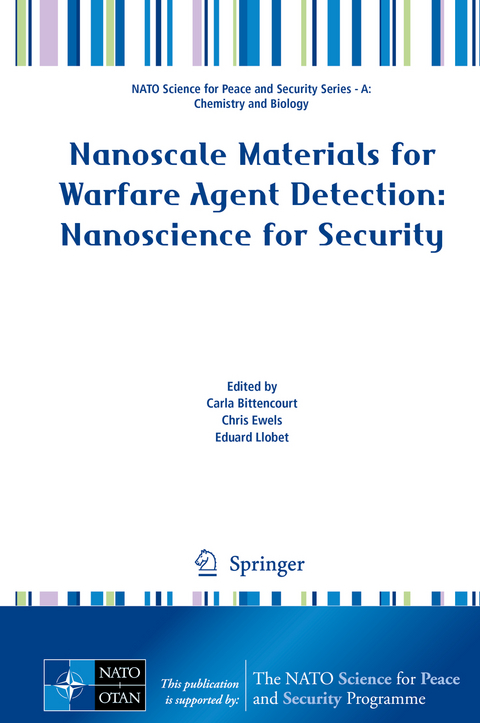
Nanoscale Materials for Warfare Agent Detection: Nanoscience for Security
Springer (Verlag)
978-94-024-1622-0 (ISBN)
The book also includes electronic structure calculations exploring the atomic and quantum mechanical mechanisms behind molecular binding and identification, so as to provide readers with an in-depth understanding of the capabilities and limitations of various nanomaterial approaches. Gathering contributions by scientists with diverse backgrounds, the book offers a wealth of insightful information for all scientists whose work involves material science and its applications in sensing.
Carla Bittencourt studied physics at the University Federal Fluminense (Brazil). Next she completed a joint Ph.D. program at the University of Campinas (Brazil) and the University La Sapienza (Italy) (1998), focusing on surface and interface analysis. After a nomination for a Postdoctoral Fellowship at the University of Warwick (UK) in 1998 to study the interaction of molecules and atoms with metallic surfaces, she joined the University of Namur (Belgium) as a Postdoctoral Researcher in 2002. In 2014 she was appointed Research Associate (F.R.S.-FNRS) at the University of Mons (Belgium). She has been an active user of synchrotron X-ray spectromicroscopy, and conduct experiments at CLS (Canada), Elettra (Italy) and BESSY II (Germany). Her present research activities are focused on the chemical functionalization and characterization of nanostructures using X-ray photoelectron spectromicroscopy and electron microscopy. Doctor Bittencourt’s research interests include metal oxide nanostructures, doping of 2D materials – transition metal dicalchogenides and carbon based-nanostructures. Christopher P. Ewels is a CNRS Research Director at the Institute of Materials Jean Rouxel, Nantes, France, and a visiting professor at Toyo University, Japan. He received his Ph.D. degree in 1997 from Exeter University, followed by postdoc at Sussex University, ONERA Paris, and a Marie Curie Individual Fellowship at Paris South University, before joining the CNRS in 2005. He coordinates the Marie Skłodowska-Curie “Enabling Excellence” training network on nanocarbons. He is active in science communication and has previously worked for the science communication charity “The Vega Science Trust”, producing science videos. His research focuses on atomic scale computer modelling and electron microscopy of nanoscale carbons, notably defect structures, chemical functionalization, and rational materials design. Eduard Llobet is full professor at the Departament d'Enginyeria Electrònica, Elèctrica i Automàtica of the Universitat Rovira i Virgili, where he obtained a tenured position in 1996. He was awarded a PhD in Telecom Eng in 1997 from the Universitat Politècnica de Catalunya and then joined the Sensor Research Lab (UWarwick, UK) for a postdoc. In 2006 and 2014 he was invited researcher at the CNRS-IMS in Bordeaux (France) and at Institut Pascal in Clermon Ferrand (France) in 2016. From 2010 to 2014 he was Director of the Research Centre on Engineering of Materials and micro/nano Systems. In 2012 he received the URV's RQR Award for quality in research and the ICREA Academia Award. He has authored near 200 papers at peer-reviewed journals (over 5000 citations) and 6 patents. Prof. Llobet is currently addressing the fabrication of sensor arrays employing low-dimensional metal oxides and/ or functionalized carbon nanomaterials. Cost-effective and industrially scalable methods such as chemical vapour deposition or aerosol-assisted chemical vapour deposition are considered for bottom-up integration in MEMS or flexible platforms. The applications sought are the development of sensitive and selective gas microsensors for environmental monitoring, medicine or safety.
The feasibility of graphene-based defense applications: an industry perspective.- Carbon nanomaterials integrated in rugged and inexpensive sensing platforms for the in-field detection of chemical warfare agents;.- Sensing volatile organic compounds by phthalocyanines with metal centers: exploring the mechanism with measurements and modelling.- Chemical sensors for VOC detection in indoor air: focus on formaldehyde.- Gas sensing using monolayer MoS2; R. Canton-Vitoria et al.- Progress of Sensors based on hollow metal sulfides nanoparticles.- Synthesis of 3D-ensembles of carbon nanotubes.- Challenges on the production and characterization of B-doped single-walled carbon nanotubes.- Graphene-based metal-free catalysis: a spectroscopic point-of-view.- Graphene for Photodynamic Therapy.
| Erscheinungsdatum | 13.09.2019 |
|---|---|
| Zusatzinfo | 90 Illustrations, black and white; VIII, 251 p. 90 illus. |
| Verlagsort | Dordrecht |
| Sprache | englisch |
| Maße | 155 x 235 mm |
| Themenwelt | Naturwissenschaften ► Chemie ► Analytische Chemie |
| Naturwissenschaften ► Physik / Astronomie ► Atom- / Kern- / Molekularphysik | |
| Naturwissenschaften ► Physik / Astronomie ► Festkörperphysik | |
| Technik ► Maschinenbau | |
| Schlagworte | functionalisation of nanostructures • Kirkendall Effect • Nanotech for defense • nanotechnology for gas sensing • theoretical modelling of bi-dimensional materials |
| ISBN-10 | 94-024-1622-6 / 9402416226 |
| ISBN-13 | 978-94-024-1622-0 / 9789402416220 |
| Zustand | Neuware |
| Informationen gemäß Produktsicherheitsverordnung (GPSR) | |
| Haben Sie eine Frage zum Produkt? |
aus dem Bereich


